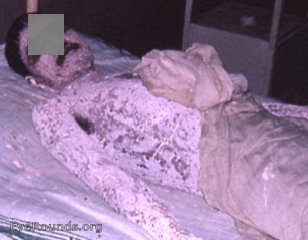EyeRounds Online Atlas of Ophthalmology
Contributor: William Charles Caccamise, Sr, MD, Retired Clinical Assistant Professor of Ophthalmology, University of Rochester School of Medicine and Dentistry
*Dr. Caccamise has very generously shared his images of patients taken while operating during the "eye season" in rural India as well as those from his private practice during the 1960's and 1970's. Many of his images are significant for their historical perspective and for techniques and conditions seen in settings in undeveloped areas.
Category: Pediatrics
Smallpox

This child with active smallpox is apparently on the road to recovery. The crusting lesions are covered with calamine lotion. The crusting pocks are primarily in the distal portions of the body, i.e. the face, the arms and the legs. This child has a good chance of escaping blindness through corneal pathology - especially since attention is being given to proper lubrication of the eyes and adequate vitamin intake. Again, the ulcus serpens that involves the corneas of so many late stage smallpox patients is not due to the smallpox virus but due to invasion by secondary invaders, e.g.pneumococci. The battle cry to prevent blindness in smallpox patients should be: Protect the cornea at all cost.

Smallpox - 1966: The last naturally occurring case of smallpox was in 1977. In 1980, WHO declared that smallpox had been eliminated from the face of the earth. The photo of his patient with active smallpox was taken by Dr. Caccamise in 1966.
Smallpox History

Ophthalmic Atlas Images by EyeRounds.org, The University of Iowa are licensed under a Creative Commons Attribution-NonCommercial-NoDerivs 3.0 Unported License.


